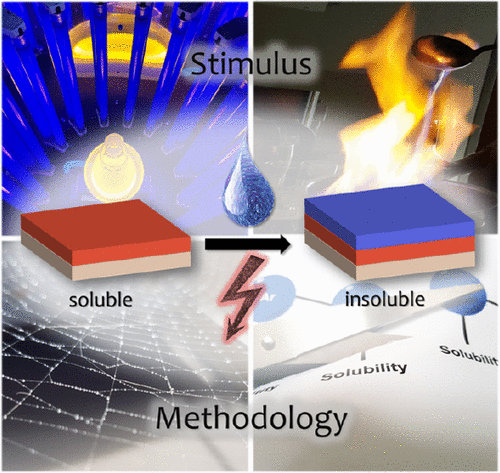当前位置:
X-MOL 学术
›
Chem. Rev.
›
论文详情
Our official English website, www.x-mol.net, welcomes your
feedback! (Note: you will need to create a separate account there.)
Immobilization Strategies for Organic Semiconducting Conjugated Polymers
Chemical Reviews ( IF 51.4 ) Pub Date : 2018-05-30 00:00:00 , DOI: 10.1021/acs.chemrev.8b00063 Jan Freudenberg 1, 2 , Daniel Jänsch 1, 2 , Felix Hinkel 1 , Uwe H. F. Bunz 1
Chemical Reviews ( IF 51.4 ) Pub Date : 2018-05-30 00:00:00 , DOI: 10.1021/acs.chemrev.8b00063 Jan Freudenberg 1, 2 , Daniel Jänsch 1, 2 , Felix Hinkel 1 , Uwe H. F. Bunz 1
Affiliation

|
This Review details synthetic routes toward and properties of insoluble polymeric organic semiconductors obtained through desolubilization strategies. Typical applications include fixation of donor–acceptor bulk-heterojunction morphologies in organic photovoltaic cells, cross-linking of charge transport materials and active emitters in light emitting diodes or similar devices, and immobilization of morphologies in field effect transistors. A second important application is the structuring of organic semiconductors, using them as photoresists. After desolubilization, removal of the nonirradiated resist leads to elevated, micron-sized features of the semiconductor. In this Review, different strategies for desolubilization are covered. By photochemical or thermal cleavage of solubility-mediating groups such as esters, sulfonium salts, amides, ethers, and acetals or by retro-Diels–Alder reactions, volatile elimination products and the insoluble semiconductor are formed. In another case, desolubilization is achieved by cross-linking via functional groups present in the polymer side chains including vinyl, halide, silicone, boronic acid, and azide functionalities, which polymerize thermally or photochemically. Alternatively, small molecular additives such as photoacids, oligothiols, or oligoazides result in network formation in combination with compatible functional groups present in the immobilizable polymers. Advantages and disadvantages of the respective methods are discussed.
中文翻译:

有机半导体共轭聚合物的固定化策略
本综述详细介绍了通过去增溶策略获得的不溶性聚合有机半导体的合成路线和性能。典型应用包括固定有机光伏电池中的供体-受体体-异质结形态,发光二极管或类似器件中的电荷传输材料和有源发射极的交联,以及将形态固定在场效应晶体管中。第二个重要的应用是将有机半导体用作光致抗蚀剂的结构化。脱脂后,去除未辐照的抗蚀剂会导致半导体的微米级特征升高。在本评论中,涵盖了不同的去溶解策略。通过光化学或热裂解溶解度调节基团,例如酯,sulf盐,酰胺,醚,与乙缩醛或通过逆Diels-Alder反应,形成挥发性消除产物和不溶性半导体。在另一种情况下,通过经由存在于聚合物侧链中的官能团(包括乙烯基,卤化物,硅酮,硼酸和叠氮化物官能团)存在的官能团交联来实现脱脂,所述官能团热或光化学聚合。或者,小分子添加剂,例如光酸,寡硫醇或寡叠氮化物,与可固定聚合物中存在的相容性官能团结合,导致网络形成。讨论了各个方法的优缺点。通过经由存在于聚合物侧链中的官能团(包括乙烯基,卤化物,硅酮,硼酸和叠氮化物官能团)存在的官能团交联来实现去增溶作用,所述官能团热或光化学聚合。或者,小分子添加剂,例如光酸,寡硫醇或寡叠氮化物,与可固定聚合物中存在的相容性官能团结合,导致网络形成。讨论了各个方法的优缺点。通过经由存在于聚合物侧链中的官能团(包括乙烯基,卤化物,硅酮,硼酸和叠氮化物官能团)存在的官能团交联来实现去增溶作用,所述官能团热或光化学聚合。或者,小分子添加剂,例如光酸,寡硫醇或寡叠氮化物,与可固定聚合物中存在的相容性官能团结合,导致网络形成。讨论了各个方法的优缺点。
更新日期:2018-05-30
中文翻译:

有机半导体共轭聚合物的固定化策略
本综述详细介绍了通过去增溶策略获得的不溶性聚合有机半导体的合成路线和性能。典型应用包括固定有机光伏电池中的供体-受体体-异质结形态,发光二极管或类似器件中的电荷传输材料和有源发射极的交联,以及将形态固定在场效应晶体管中。第二个重要的应用是将有机半导体用作光致抗蚀剂的结构化。脱脂后,去除未辐照的抗蚀剂会导致半导体的微米级特征升高。在本评论中,涵盖了不同的去溶解策略。通过光化学或热裂解溶解度调节基团,例如酯,sulf盐,酰胺,醚,与乙缩醛或通过逆Diels-Alder反应,形成挥发性消除产物和不溶性半导体。在另一种情况下,通过经由存在于聚合物侧链中的官能团(包括乙烯基,卤化物,硅酮,硼酸和叠氮化物官能团)存在的官能团交联来实现脱脂,所述官能团热或光化学聚合。或者,小分子添加剂,例如光酸,寡硫醇或寡叠氮化物,与可固定聚合物中存在的相容性官能团结合,导致网络形成。讨论了各个方法的优缺点。通过经由存在于聚合物侧链中的官能团(包括乙烯基,卤化物,硅酮,硼酸和叠氮化物官能团)存在的官能团交联来实现去增溶作用,所述官能团热或光化学聚合。或者,小分子添加剂,例如光酸,寡硫醇或寡叠氮化物,与可固定聚合物中存在的相容性官能团结合,导致网络形成。讨论了各个方法的优缺点。通过经由存在于聚合物侧链中的官能团(包括乙烯基,卤化物,硅酮,硼酸和叠氮化物官能团)存在的官能团交联来实现去增溶作用,所述官能团热或光化学聚合。或者,小分子添加剂,例如光酸,寡硫醇或寡叠氮化物,与可固定聚合物中存在的相容性官能团结合,导致网络形成。讨论了各个方法的优缺点。











































 京公网安备 11010802027423号
京公网安备 11010802027423号